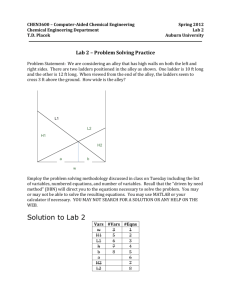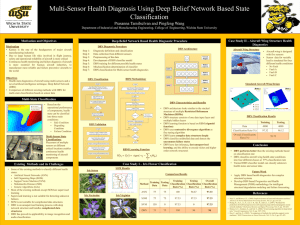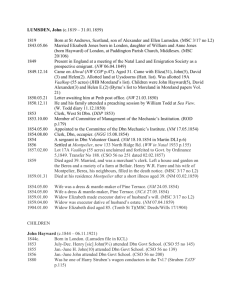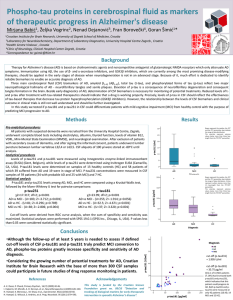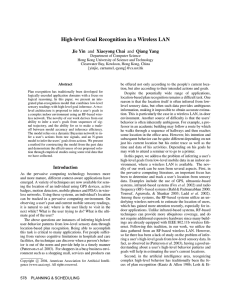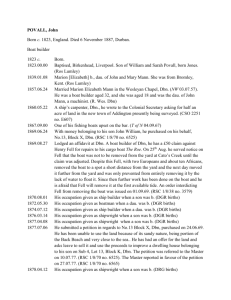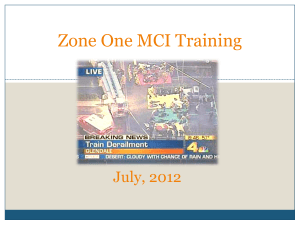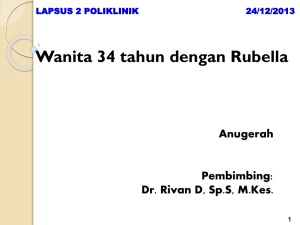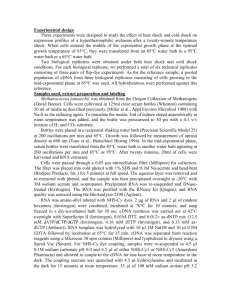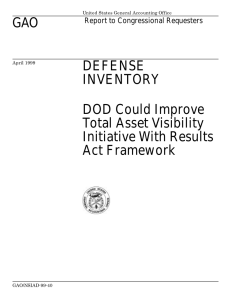Radioactive Decay - uthgsbsmedphys.org
advertisement
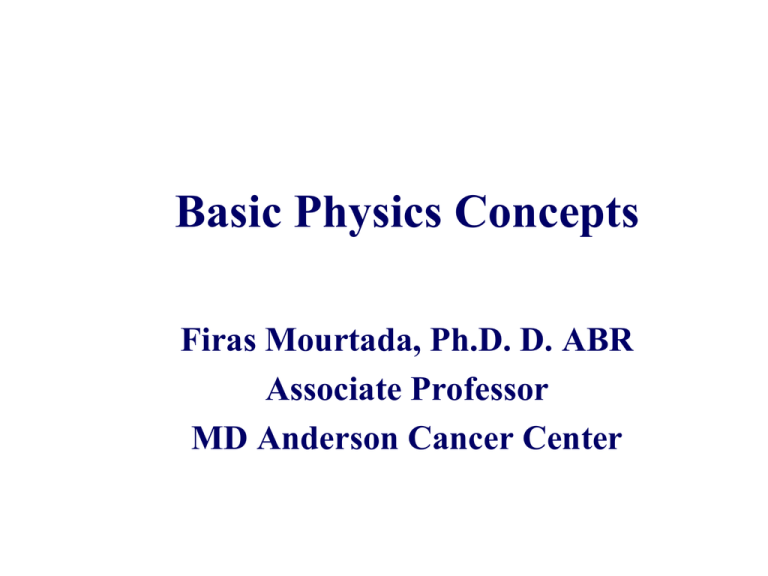
Basic Physics Concepts
Firas Mourtada, Ph.D. D. ABR
Associate Professor
MD Anderson Cancer Center
Radioactive Decay
dN/dt = -lN
dN/N = -ldt
N(t) = N0e-lt
N0 = initial number
N(t) = number at time t
l = decay constant
Half - life
N(t)/N0 = 0.5 = e-lt
ln(0.5) = -lt
t = T1/2 = 0.693/l
half-life of 198Au
half life 2.7 days
1.000
0.900
fraction of remaining activity
0.800
0.700
0.600
0.500
0.400
0.300
0.200
0.100
0.000
0
5
10
15
days
20
25
30
Decay of Au198
Half-life = 2.7 days
Days
1.000
1.000
0
0
5
5
10
10
15
15
Fraction of Initial Activity
Fraction of Initial Activity
0.100
0.100
0.010
0.010
0.001
0.001
0.000
0.000
Days
20
20
25
Decay
25 of Au198
Half-life = 2.7 days
Decay of Au198
Half-life = 2.7 days
30
30
Half - Lives
Isotope
226Ra
137Cs
198Au
192Ir
125I
103Pd
Half - Life
1620 years
30 years
2.7 days
73.83 days
59.4 days
16.97 days
Mean life
N(t)/N0 = e-1 = e-lt
lt = 1
t = Tav =1/l
Tav = T 1/2/.693 = 1.44 T 1/2
Au198 half-life vs mean life
Half-life = 2.7 days
1.0
Fraction of Initial Activity
0.9
half-life
mean life
0.8
0.7
0.6
0.5
0.4
0.3
0.2
0.1
0.0
0
5
10
15
Days
20
25
30
Brachytherapy Source Strength Specification
Sealed photon source
Encapsulated so radioactive material can not
be lost from physical or chemical stress
under foreseeable circumstances. Usually
double metal wall encapsulation, prevents
escape of radioactive material and absorbs
unwanted betas.
All brachytherapy sources are sealed sources
except 192Ir wire or hairpins, which have
core exposed when cut. ISO considers 192Ir
wire or hairpins to be a closed source.
Brachytherapy Source Strength Specification
Mass-
Early 20th century
Activity-
Early 20th century
Apparent Activity-Mid 20th century
Air Kerma Strength-Late 20th century
Mass
Radium
– Mme. Curie prepared first 226Ra standards,
quantified amount by expressing mass of
sample in g or mg.
Activity
226Ra alpha decays to 222Rn, all photons
are emitted by radon or radon daughter
products.
222Radon seeds produced by collecting
radon gas from decay of radium and
encapsulating in gold tubing.
Method needed to permit correlation of
222Rn to 226Ra clinical experience.
Activity
Defined 1 Curie (Ci) to be the amount of
radon in equilibrium with 1 g of radium.
A 1 Ci radon seed has same activity as 1 g
of radium.
Early experiments indicated 1 Ci of
radon emitted 3.7 * 1010 alpha per
second.
1 Ci defined as 3.7*1010 disintegrations
per second (d.p.s.).
Activity
Later experiments established amount of
radon in equilibrium with 1 g of radium
gives 3.61 * 1010 d.p.s.
Curie definition remains 3.7 *1010 d.p.s.
milliCurie (mCi) is 3.7 * 107 d.p.s.
Roughly, conversion is 27 mCi per 1 GBq
Apparent Activity
Apparent activity - activity of a bare
source that produces the same exposure
rate at calibration distance as the
specified source.
Expressed in mCi for brachytherapy.
Particularly useful for low energy photon
sources, e.g., 125I, 103Pd
mgRaeq
Post WWII, other reactor produced
isotopes began to be used as radium
substitutes in radiotherapy.
Source strength was expressed in mCi,
but also needed a method to take
advantage of clinical experience with
radium.
Used mgRaeq.
mgRaeq
mgRaeq yields same exposure rate at
calibration distance as 1 mg Ra
encapsulated by 0.5mm Pt.
The exposure rate at 1 cm from 1 mg
Ra(0.5mm) is 8.25R/hr.
Exposure Rate constant (G) is
G = 8.25 [(R-cm2)/(mg-hr)] - Ra(0.5mm Pt)
G = 7.71 [(R-cm2)/(mg-hr)] - Ra(1.0mm Pt)
mg-hours or mgRaeq-hours
Number of mg or mgRaeq in implant
times the duration of the implant in
hours
Source Specification
Activity - mCi - 3.7 x 107 d.p.s.
Apparent activity - activity of a bare point
source that produces same exposure rate
at calibration distance as the specified
source.
mg Ra eq - amount of 226Ra that produces
same exposure rate at calibration
distance as specified isotope
Exposure Rate Constants
Isotope
226Ra (0.5mmPt)
137Cs
192Ir
198Au
125I
103Pd
Gd(R-cm2/mCi-hr)
8.25
3.3
4.69
2.38
1.51
1.48
Conversion - mCi to mg Ra eq
# of mg Ra eq = (Gx/GRa) * # of mCix
Conversion - mCi to mg Ra eq
Examples
137Cs
# of mg Ra eq = (3.3/8.25) * # of mCi137Cs
= 0.4 * # of mCi137Cs
192Ir
# of mg Ra eq = (4.69/8.25) * # of mCi192Ir
= 0.569* # of mCi192Ir
1 mCi of
137Cs
-dN / dt = 3.7 * 107 dps = lN
N = 3.7*107 dps / l
l = 0.693 / T1/2 = 0.693 / (30 y * p * 107 s/y)
l = 7.36 *10-10 s-1
N = 5.03 * 1016 atoms of 137Cs
A0 = 6.023 * 1023 atoms per 137 g (1 mole)
of 137Cs
Mass of 1mCi =
(5.03 * 1016 / 6.02 * 1023)*137 = 10 mg
Dose Rate Calculation - Seeds
dD/dt = A G f Btiss Bw Bs fan /d2
A = activity
G = exposure rate constant
f = f-factor - R to cGy conversion factor
Btiss = attenuation and scattering in tissue
Bw, Bs = attenuation and scattering for
source encapsulation and self attenuation
fan= anisotropy factor
d = distance to calculation point
Attenuation and Scattering
Functions
Tissue
Btiss = 1+ka(md)kb
Btiss = a + bd + gd2 +Dd3
Wall
Bw = exp(-mwtw)
Source
Bs = exp(-msts)
Meisberger Coefficients
Ratio of in-water exposure to in-air
exposure - Tissue attenuation/scattering
Meisberger, L.L., Keller, R., Shalek, R.J.,
The effective attenuation in water of
gold-198, iridium-192, cesium-137,
radium-226, and cobalt-60, Radiology 90,
953, 1968.
Meisberger ratio = A + Br + Cr^2 + Dr^3, r distance in cm from
source to point of calculation
A
B
C
D
r(cm)
0.50000
1.00000
1.50000
2.00000
2.50000
3.00000
3.50000
4.00000
4.50000
5.00000
Cs137
1.009100000
-0.009015000
-0.000345900
-0.000028170
Cs137
1.00450
0.99971
0.99470
0.98946
0.98396
0.97818
0.97210
0.96570
0.95896
0.95186
Ir192
Au198
Ra226
1.012800000 1.036000000 1.000500000
0.005019000 -0.008134000 -0.004423000
-0.001178000 0.001111000 -0.001707000
-0.000020080 -0.000159700 0.000074480
Ir192
Au198
Ra226
1.01501
1.03219
0.99787
1.01662
1.02882
0.99444
1.01761
1.02576
0.99028
1.01797
1.02290
0.98542
1.01767
1.02011
0.97994
1.01671
1.01729
0.97388
1.01508
1.01429
0.96730
1.01274
1.01102
0.96026
1.00970
1.00734
0.95282
1.00594
1.00314
0.94502
Meisberger Ratio
Cs137
1.04
Ir192
Au198
1.03
Ra226
Dose in water/Dose in air
1.02
1.01
1.00
0.99
0.98
0.97
0.96
0.95
0.94
0.00
1.00
2.00
3.00
distance from source(cm )
4.00
5.00
6.00
Dose Rate Calculation - Linear Sources
Quantization Method - divide source into
multiple point sources
Quantization Method
Quantization Method
Dose Rate Calculation - Linear Sources
Sievert Integral
q2
dD ( x , y ) / dt = {( A G B tiss B s ) / Ly } exp( m t ) sec q d q
q1
L = active length
y = perpendicular distance from source to
calculation point
m = effective attenuation coefficient of wall
q= as defined in diagram
Sievert Integral Source Geometry
140.00
Com parison of linear source to point source
Ra filtered by 0.5 m m Pt
linear source - Shalek & Stovall
120.00
cGy/mg-hr
100.00
1.5 cm AL
80.00
point
60.00
40.00
20.00
0.00
0.00
0.50
1.00
1.50
2.00
2.50
distance(cm )
3.00
3.50
4.00
4.50
5.00
% difference between 1.5cm Ra source and point Ra source
60.00%
50.00%
40.00%
30.00%
20.00%
10.00%
0.00%
0.00
1.00
2.00
3.00
distance(cm)
4.00
5.00
6.00
cGy/mg-hr
dist(cm) 1.5 cm AL point
0.25
50.67
126.23
0.50
20.26
31.51
0.75
10.84
13.98
1.00
6.67
7.85
1.50
3.20
3.47
2.00
1.85
1.95
2.50
1.20
1.24
3.00
0.83
0.85
3.50
0.61
0.62
4.00
0.47
0.47
4.50
0.37
0.37
5.00
0.30
0.30
% diff
59.86%
35.71%
22.48%
15.05%
7.91%
4.89%
3.06%
2.85%
2.16%
0.81%
0.40%
-0.52%
Away & Along Tables
Young - Batho
Shalek - Stovall
Krishnaswamy
Young and Batho,
British Journal of Radiology,
37, 38, 1962.
Young-Batho Source Geometry
Shalek and Stovall, American
Journal of Roentgenology,
Radium Therapy and Nuclear
Medicine, CII, 662, 1968.
Shalek &
Stovall
Example
Krishnaswamy, Radiology 105,
181, 1972.
ACR Standards
www.acr.org
ACR Standard on Brachy Physics
Manually-Loaded Temporary Implants
Section IV.C.3.
An additional and independent method
should be used to validate the dose
calculation results of the computerized
planning systems. This validation should
be consistent with the written
prescription and completed before 50%
of the dose is delivered.
End of Lecture 1
Implant Doses
Permanent Implant
– D = (dD0/dt )Tav
Temporary Implant with T1/2>>T
– D = (dD0/dt ) T
Temporary Implant with T1/2 not >> T
– D = (dD0/dt ) Tav[1 - exp(-T/Tav)]
– “milliCuries destroyed”
Temporary Implant T1/2 not >>T
t
D = ( dD 0 / dt ) exp( l t ) dt
0
D = (dD0/dt)[-{exp(-lt)}/{l}]0t
D = (dD0/dt)[-{exp(-lT)/l} +{1/l}]
D = ((dD0/dt) /l)[1-exp(-lT)]
D = (dD0/dt) Tav[1-exp(-lT)]
D = (dD0/dt) Tav[1-exp(-T/Tav)]
milliCuries destroyed
D = (dD0/dt) Tav[1-exp(-lT)]
D = (dD0/dt) Tav- (dD0/dt) exp(-lT) Tav
D = (dD0/dt) Tav - (dDT/dt) Tav
Radiation Protection
Time
Distance
Shielding
Time
Dose is proportional to exposure time
Half the time equals half the dose
Distance
For radiation protection purposes can
assume dose follows inverse square law.
Dose at 1 cm
=
4 * Dose @ 2cm
=
0.25 Dose @ 0.5cm
Photon Energies
Isotope
226 Ra
137Cs
192Ir
198Au
125I
103Pd
Energies(MeV)
0.047 - 2.45 (ave 0.83)
0.662
0.136 - 1.06 (ave 0.38)
0.412
0.0274 - 0.0355 (ave 0.028)
0.0201, 0.023 (ave 0.021)
Half -Value Layers
Isotope
226Ra
137Cs
192Ir
198Au
125I
103Pd
HVL(mm of Pb)
8.0
5.5
2.5
2.5
0.025
0.008
Radiation Protection Example
125I Calculation
Assume 125I prostate implant 10 cm to patient
surface, 50 mCi total activity, tissue attenuates
95% of dose at 10 cm (5% transmission).
(dXsurface /dt) = 1.51 * 50 * (1/10)2 * 0.05 =38 mR/hr
(dX1m/dt) = 38 mR/hr * (10/100)2 = 0.4 mR/hr
